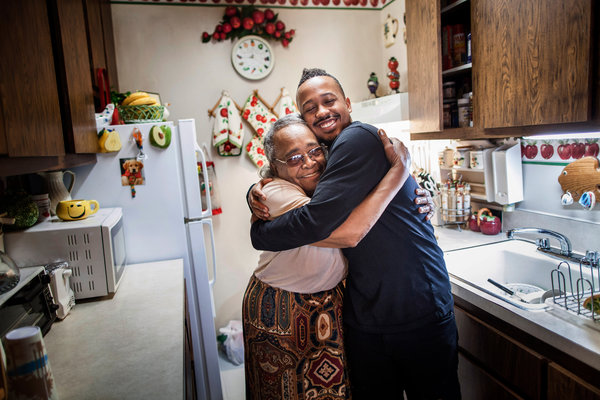
A Bronx Tale
CreditKatie Orlinsky for The New York Times
Hanging out on the corner of Fordham Road and the Grand Concourse in the Bronx will not yield a lot of clues about how Malcolm Livingston II first got fired up about food.
At 28, Mr. Livingston has been the head pastry chef at WD-50 for almost four years, and he recently landed a job that may be described as a wild Scandinavian plum: In December, after WD-50’s bold 11 ½-year run of boundary-pushing cuisine ends, he will move from New York to Denmark to conjure up desserts at Noma, the Copenhagen restaurant that some critics have called the best in the world.
The chef at Noma, René Redzepi, has drawn wide acclaim for a new form of cooking that is largely rooted in foraging for nibbles from nearby forests, fjords, meadows, dunes and tide pools. Mr. Livingston, a veteran of the kitchens at Le Cirque and Per Se, is the first to admit that he has zero experience with that.
When he showed up on a chilly Monday morning last month at this corner of his home borough, in a neighborhood he associates with memories of buying sneakers and catching the D train, it was clear that an ad hoc foraging expedition would turn up nothing more natural than a Whopper. There weren’t even weeds poking through sidewalk cracks.

“That’s the thing that’s crazy,” said Mr. Livingston, dressed for his day off in red high-tops and ripped black jeans. “Even in a bodega, there’s not much fruit. It’s all processed.”
So how to explain the course of his career, which has carried him from these streets dominated by fast-food chains to some of the most influential and experimental kitchens in global gastronomy? To solve that puzzle, Mr. Livingston and his wife, Mika, hopped into a cab and made a pilgrimage to Stevenson Commons, an apartment complex a few blocks from the Bruckner Expressway. The person who had the answer, it turned out, was Aunt Alice.
Aunt Alice is Alice Pulley, an 83-year-old deacon at Friendly Baptist Church and the sister of Mr. Livingston’s paternal grandmother. When Mr. Livingston dropped by to visit her that morning (“I haven’t seen this little rascal in a long time,” she said), it did not take long to detect the roots of his fascination with sweets.
Mr. Livingston nodded toward the kitchen as memories of poundcake and pecan pie poured forth. “This whole counter — she would have a little cake display,” he said. When he was 5 or 6, he and his playground comrades became passionate advocates for Ms. Pulley’s baking.
“They would come over — ‘Auntie, where are the goodies?’ ” she said. “Oh, Lord. Cakes, pies: Whatever they asked for, I would try to fix it for them.”
Her signature dish, and the one that would wind up being pivotal in Mr. Livingston’s life, was a banana pudding filled with alternating layers of sliced bananas and Nilla wafers. She made the custard itself with eggs and milk, instead of relying on a powder from the supermarket, and she achieved the texture she wanted by way of flour, instead of cornstarch.
“I’m telling you, that banana pudding, really, it’s life-changing,” Mr. Livingston said. “Flour instead of starch: There’s a difference, man. Molecular level over here.”
Although his career path as a pastry chef later picked up momentum when he graduated from culinary school and got a job, while still in his teens, at Le Cirque, it really started with that banana pudding.
Ms. Pulley spent her own childhood on a farm in Virginia, and while Mr. Livingston lingered in his aunt’s apartment, where a pan of pulled pork released its vinegary fragrance, he mused aloud on how he might reinvent something like a Southern sweet-potato pie. A touch of tamarind may intensify the dish.
“How about throw some cornflakes in there?” Ms. Pulley interjected.
Mr. Livingston smiled. “That’s a dessert right there,” he said. “Cornflakes, sweet potato and tamarind.”
Mr. Livingston’s parents moved around the borough; he grew up surrounded by an extended family. When it comes to the development of his palate, he gives equal billing to his mother’s family, whose roots go back to Barbados. (At WD-50, he once enlisted hibiscus, anise and grapefruit in a dessert based on the herbal flavors of sorrel, a traditional Caribbean drink.)
Cooking Newsletter
New recipes from The New York Times, delivered to your inbox three times a week.
And he credits WD-50, and its head chef, Wylie Dufresne, with pushing him to detonate his preconceptions about what dessert is supposed to be.
Mr. Redzepi said, “When someone spends that much time there, you can bet that they will have the curiosity and openness that I think are necessary to enjoy your time here.”
Mr. Livingston’s predecessor at Noma, Rosio Sánchez, is gearing up to open a taqueria in Copenhagen. She also paid her dues as part of the pastry squadron at WD-50, and when Mr. Livingston rose to the top pastry job there, he was following in the footsteps of Sam Mason and Alex Stupak, both of whom were spoken of in language that is usually reserved for the likes of Stephen Hawking. “I pushed that guy hard,” Mr. Dufresne said. “I hammered him a lot. I didn’t make it easy for him.”
In the end, Mr. Dufresne said, “he rose to the challenge.”
On both sides of Mr. Livingston’s family, though, his impending journey to Noma and his waning weeks in the laboratory of WD-50 remain something of a benign mystery.
“Now, where you going?” Ms. Pulley asked as Mr. Livingston gazed at the city from her window.
“I’m going to Copenhagen, in Denmark,” he said. “I’m going to this restaurant called Noma, which is basically the best restaurant in the world.”
She nodded gently. “Wow,” she said. “Don’t worry, you’re going to do good.”
Mr. Livingston, who graduated from Jacqueline Kennedy Onassis High School in Manhattan and studied in the culinary program at the Art Institute of New York City, said his immediate relatives had never tasted his desserts at WD-50. They come from a world different than the one he inhabits now. “They just know me as Little Mac, just eating,” he said. “They don’t get caught up in it.”
He has no choice but to get caught up. In January, after only a month of wrapping his head around Scandinavian ingredients like aronia berries, skyr and sea buckthorn, Mr. Livingston will travel with the Noma team to Japan to create curtain-closers for a temporary Tokyo version of the restaurant. His wife grew up in Japan, and Mr. Livingston has studied Japanese ingredients (from rare melons to vending-machine confections) on past trips. Mr. Redzepi’s penchant for tossing curveball ingredients to his crew does not seem to faze him.
“If he says, ‘Do something with onion,’ onions are so sweet,” he said. “Apples and onion. Apples and shallots. Apples and shallots and beer. I could go on for days with just flavors.”
After the trip to Stevenson Commons, the Livingstons caught another cab out to City Island, a pocket of the Bronx that can feel more like coastal Maine than a patch of metropolis. As he roamed around the docks near where, as a teenager, he used to play video games and chow down on fried calamari, he already seemed to be surveying the landscape in a fresh way.
“You want to go foraging?” he asked, pointing to some scraggly tufts of beach grass. Then he spied some plump local poultry.
“A pigeon,” he said. “Laying an egg right here. First of the season.”